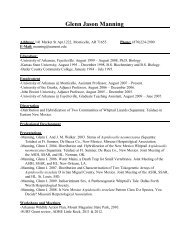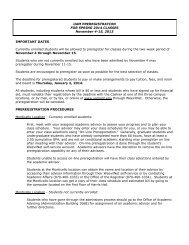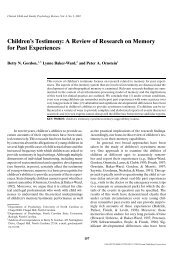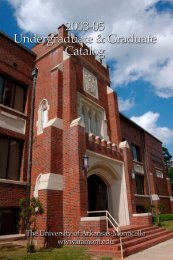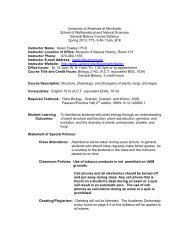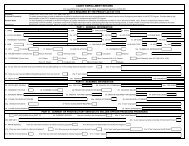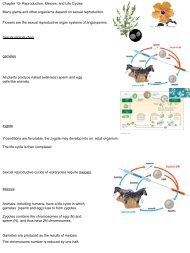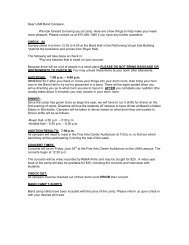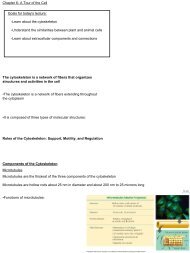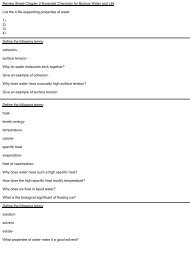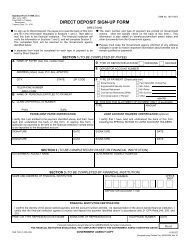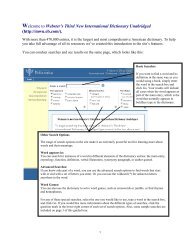Chapter 5-The Working Cell-Membrane Structure and Function ...
Chapter 5-The Working Cell-Membrane Structure and Function ...
Chapter 5-The Working Cell-Membrane Structure and Function ...
- No tags were found...
You also want an ePaper? Increase the reach of your titles
YUMPU automatically turns print PDFs into web optimized ePapers that Google loves.
Water balance in animal <strong>and</strong> plant cellsWhat direction will water move in the following animal cell example?isotonic solution hypotonic solution hypertonic solution<strong>The</strong> red blood cell in the hypotonic solution is an example of _________________.<strong>The</strong> red blood cell in the hypertonic solution is an example of ________________.What direction will water move in the following plant cell example?isotonic solution hypotonic solution hypertonic solution<strong>The</strong> plant cell in the hypotonic solution is an example of ________________.<strong>The</strong> plant cell in the hypertonic solution is an example of ________________.Differentiate between active <strong>and</strong> passive transport.Matching___ sodium potassium pump___ diffusionA. active transportB. passive transport___ channel proteins in facilitated diffusion___ osmosis___ proton pump (cotransport)<strong>The</strong> major electrogenic pump of animal cells is __________________.<strong>The</strong> major electogenic pump of plant cells is _____________________.Differentiate between exocytosis <strong>and</strong> endocytosis.List the three types of endocytosis.
<strong>Chapter</strong> 5-<strong>The</strong> <strong>Working</strong> <strong>Cell</strong>-Basic Energy Concepts, ATP, <strong>and</strong> EnzymesDefine the following terms:metabolismcatabolic pathway (Give an example).anabolic pathway (Give an example).Define basis energy concepts:energywork<strong>The</strong> 1 st Law of <strong>The</strong>rmodynamics<strong>The</strong> 2 nd Law of <strong>The</strong>rmodynamicsIn the figure provided, the person climbing the steps to the diving platform converts ________ energy to__________ energy.<strong>The</strong> diver on the platform has more _________ energy. Explain.When the person dives into the water, ___________energy is converted to _______ energy.Where has the energy gone once the diver hits the water?Define free energy (G).Differentiate between an exergonic <strong>and</strong> endergonic reaction.Are the following reactions endergonic or exergonic? Explain why.NH 2GluGlutamicacid+NH 3AmmoniaGluGlutamineΔG = +3.4 kcal/molATP + H 2 O ADP + P iΔG = –7.3 kcal/mol
What is ATP?How does ATP power the work of our cell?What is phosphorylation?List the 3 types of cellular work powered by the hydrolysis of ATP.Define enzyme.Define substrate.Define activation energy (E A).What can affect an enzyme’s activity?Differentiate between competitive inhibitors <strong>and</strong> non-competitive inhibitors.



